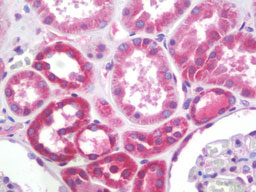CISD1 Antibody (clone AT1A8)
Mouse Monoclonal Antibody
- SPECIFICATION
- CITATIONS
- PROTOCOLS
- BACKGROUND

Application
| WB, IHC-P, E |
|---|---|
| Primary Accession | Q9NZ45 |
| Reactivity | Human |
| Host | Mouse |
| Clonality | Monoclonal |
| Clone Names | AT1A8 |
| Calculated MW | 12kDa |
| Dilution | IHC-P (10 µg/ml), WB (1:1000), |
| Gene ID | 55847 |
|---|---|
| Other Names | CDGSH iron-sulfur domain-containing protein 1, MitoNEET, CISD1, C10orf70, ZCD1 |
| Target/Specificity | Human CISD1 |
| Reconstitution & Storage | Can be stored at 4°C. For long term storage, aliquot and store at -20°C. Avoid repeated freezing and thawing cycles. |
| Precautions | CISD1 Antibody (clone AT1A8) is for research use only and not for use in diagnostic or therapeutic procedures. |
| Name | CISD1 |
|---|---|
| Synonyms | C10orf70, ZCD1 |
| Function | L-cysteine transaminase that catalyzes the reversible transfer of the amino group from L-cysteine to the alpha-keto acid 2- oxoglutarate to respectively form 2-oxo-3-sulfanylpropanoate and L- glutamate (PubMed:36194135). The catalytic cycle occurs in the presence of pyridoxal 5'-phosphate (PLP) cofactor that facilitates transamination by initially forming an internal aldimine with the epsilon-amino group of active site Lys-55 residue on the enzyme (PLP- enzyme aldimine), subsequently displaced by formation of an external aldimine with the substrate amino group (PLP-L-cysteine aldimine). The external aldimine is further deprotonated to form a carbanion intermediate, which in the presence of 2-oxoglutarate regenerates PLP yielding final products 2-oxo-3-sulfanylpropanoate and L-glutamate. The proton transfer in carbanion intermediate is suggested to be controlled by the active site lysine residue, whereas PLP stabilizes carbanion structure through electron delocalization, also known as the electron sink effect (PubMed:36194135). Plays a key role in regulating maximal capacity for electron transport and oxidative phosphorylation (By similarity). May be involved in iron-sulfur cluster shuttling and/or in redox reactions. Can transfer the [2Fe-2S] cluster to an apo-acceptor protein only when in the oxidation state, likely serving as a redox sensor that regulates mitochondrial iron-sulfur cluster assembly and iron trafficking upon oxidative stress (PubMed:17584744, PubMed:21788481, PubMed:23758282). |
| Cellular Location | Mitochondrion outer membrane; Single-pass type III membrane protein |
| Tissue Location | Expression is reduced in cells derived from cystic fibrosis patients. |
| Volume | 50 µl |
If you have used an Abcepta product and would like to share how it has performed, please click on the "Submit Review" button and provide the requested information. Our staff will examine and post your review and contact you if needed.
If you have any additional inquiries please email technical services at tech@abcepta.com.














 Foundational characteristics of cancer include proliferation, angiogenesis, migration, evasion of apoptosis, and cellular immortality. Find key markers for these cellular processes and antibodies to detect them.
Foundational characteristics of cancer include proliferation, angiogenesis, migration, evasion of apoptosis, and cellular immortality. Find key markers for these cellular processes and antibodies to detect them. The SUMOplot™ Analysis Program predicts and scores sumoylation sites in your protein. SUMOylation is a post-translational modification involved in various cellular processes, such as nuclear-cytosolic transport, transcriptional regulation, apoptosis, protein stability, response to stress, and progression through the cell cycle.
The SUMOplot™ Analysis Program predicts and scores sumoylation sites in your protein. SUMOylation is a post-translational modification involved in various cellular processes, such as nuclear-cytosolic transport, transcriptional regulation, apoptosis, protein stability, response to stress, and progression through the cell cycle. The Autophagy Receptor Motif Plotter predicts and scores autophagy receptor binding sites in your protein. Identifying proteins connected to this pathway is critical to understanding the role of autophagy in physiological as well as pathological processes such as development, differentiation, neurodegenerative diseases, stress, infection, and cancer.
The Autophagy Receptor Motif Plotter predicts and scores autophagy receptor binding sites in your protein. Identifying proteins connected to this pathway is critical to understanding the role of autophagy in physiological as well as pathological processes such as development, differentiation, neurodegenerative diseases, stress, infection, and cancer.



